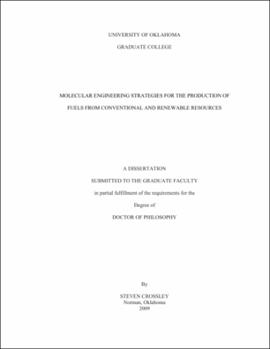| dc.contributor.advisor | Resasco, Daniel E | |
| dc.creator | Crossley, Steven Parker | |
| dc.date.accessioned | 2019-04-27T21:40:45Z | |
| dc.date.available | 2019-04-27T21:40:45Z | |
| dc.date.issued | 2009 | |
| dc.identifier | 9981242002042 | |
| dc.identifier.uri | https://hdl.handle.net/11244/319331 | |
| dc.description.abstract | The combination of Quantitative Structure Property Relationships (QSPR) with experimental studies using model compounds provides great promise for fuel upgrading. Through this approach, QSPR software is utilized to predict fuel properties of interest for model compounds as well as for any potential reaction products. Catalytic studies are performed in combination with QSPR, attempting to maximize selectivity to products with the optimal fuel properties of interest. QSPR provides the direction to which specific chemical bonds should be broken or formed to optimize fuel properties, while model compound studies relate the properties of the catalyst and reaction conditions to the selectivity towards specific products. The end result is a guided approach to catalyst design which maximizes knowledge gained, with a constant link to practical application through fuel property prediction. This methodology has a dual benefit. While practical advancement for fuel improvement is gained, fundamental knowledge is developed about relationships between specific molecules and catalysts. | |
| dc.description.abstract | In this contribution, examples will be given for the development of important fuel properties, their prediction with QSPR, and further optimization through model compound studies. A further extension of QSPR will then be made in order to predict not only fuel properties, but primary product selectivities as well. Transitioning of these strategies to oxygenated hydrocarbons more representative of renewable fuel sources (e.g. biomass) will also be discussed. This methodology allows the development of not only novel catalytic strategies utilizing conventional reactors, but also a new catalytic system with enormous potential through the use of nano-hybrids at the oil-water interface. | |
| dc.format.extent | 233 pages | |
| dc.format.medium | application.pdf | |
| dc.language | en_US | |
| dc.relation.requires | Adobe Acrobat Reader | |
| dc.subject | QSAR | |
| dc.subject | Catalysis | |
| dc.subject | Molecular theory | |
| dc.subject | Biomass energy | |
| dc.subject | Diesel fuels | |
| dc.subject | Gasoline | |
| dc.title | MOLECULAR ENGINEERING STRATEGIES FOR THE PRODUCTION OF FUELS FROM CONVENTIONAL AND RENEWABLE RESOURCES | |
| dc.type | text | |
| dc.type | document | |
| dc.thesis.degree | Ph.D. | |
| ou.group | College of Engineering::School of Chemical, Biological and Materials Engineering | |
